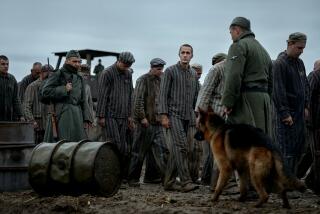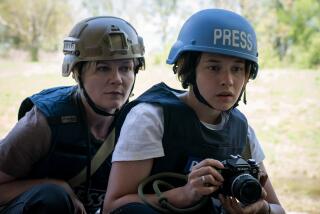TV AND THE GULF WAR : Sanitized Gap Separates Americans From War
It was only recently that many of us were predicting that the Persian Gulf crisis would become our first television war. It still may.
Yet, since that initial glut of Scud alerts and gas masks, sterility has set in, and encountering the war through TV has become like viewing the Gulf through the wrong end of a telescope and hearing bombs faintly in the distance.
Given constant reminders--from media attention to yellow ribbons to Operation Desert Storm T-shirts--this is a war that’s hard to forget, but also one whose violence and pain are easy to ignore.
The hurt gap separating the war and most of the public is so wide that it’s no wonder polls show most Americans like the coverage they’re getting and want more of it. It’s painless, an excruciating toothache disguised by Novocain.
Instead of our most televised war, this could become our most sanitized one. That is true, ironically, despite the presence in Saudi Arabia of nearly 1,000 media members and satellite technology that makes just about every event that can be reached instantly televisional.
“What people must understand is that war is a terrible business,” Group Capt. Niall Irving, a British military briefer in Riyadh, Saudi Arabia, said Tuesday on “CBS This Morning.” Yet how can they fully appreciate the terrible nature of war if that portion of it they’re exposed to through TV is largely sterilized?
Thanks mostly to tight Pentagon censorship, Americans are being parceled information on a need-to-know basis, and what they’re getting from the Gulf, particularly on TV, is rather impersonal.
There are exceptions, including some newspaper stories and some of the censored reporting coming from Baghdad. Yet Americans are mostly getting artsy shots of troops and planes against romantic orange sunsets. They’re getting slo mo, fancy graphics, radar, computers, maps and charts, plus distant pictures of bombing raids showing Nintendo-like targets going splat! in the night.
They’re getting resort-like sunny interviews in Saudi Arabia against sand and palms gently rustled by desert breezes. They’re getting officers in uniforms briefing the press, followed by retired officers in suits briefing viewers on the briefings. They’re seeing briefers such as Irving being debriefed by TV reporters on how they feel about their briefings.
Given the media’s emphasis on feelings, in fact, the Gulf conflict has become the “thirtysomething” of war stories. Again and again, we’re hearing how people feel about war--as in the stateside Marine officer in the CBS comedy “Major Dad” aching Monday to join his colleagues in “Saudi”--without ever touching war or being touched by it.
These secondhand experiences symbolically converged on NBC’s “Today” program Tuesday, when Bryant Gumbel interviewed Peg Mullen, whose campaign to uncover the truth about her son’s death in Vietnam was the basis for the 1979 TV movie “Friendly Fire,” and C.D.B. Bryan, author of the book from which the movie was drawn.
Although the interview keyed on recent GI deaths in Saudi Arabia that were blamed on “friendly fire,” its very nature--with Gumbel speaking from New York, Mullen from Brownsville, Tex., and Bryan from West Hartford, Conn.--somehow accentuated the disconnectedness of Gulf coverage.
And so did a segment on “CBS This Morning” in which a Navy artist displayed his Pentagon-commissioned paintings of troops and materiel from the Gulf that, on the screen at least, were flat and uninvolving. Instead of war pictures, war watercolors.
Whether the type of coverage we’re getting primarily reflects the war’s air focus or Pentagon paranoia or legitimate concerns for security does not alter the reality.
Ken Burns’ great PBS documentary series “The Civil War” makes a dramatic point of comparison. You pop in the episode on 1862’s bloody Battle of Antietam and almost immediately feel the emotion course through you like fire as the words and old photographs bring the conflict alive. How strange to feel nearer a war of so many years ago than the one being fought today in the Gulf.
No doubt a documentary will be made about the Persian Gulf War, too, perhaps one that captures its horrors and great sadness. For now, however, we have talking heads.
And watercolors.
More to Read
Sign up for Essential California
The most important California stories and recommendations in your inbox every morning.
You may occasionally receive promotional content from the Los Angeles Times.










